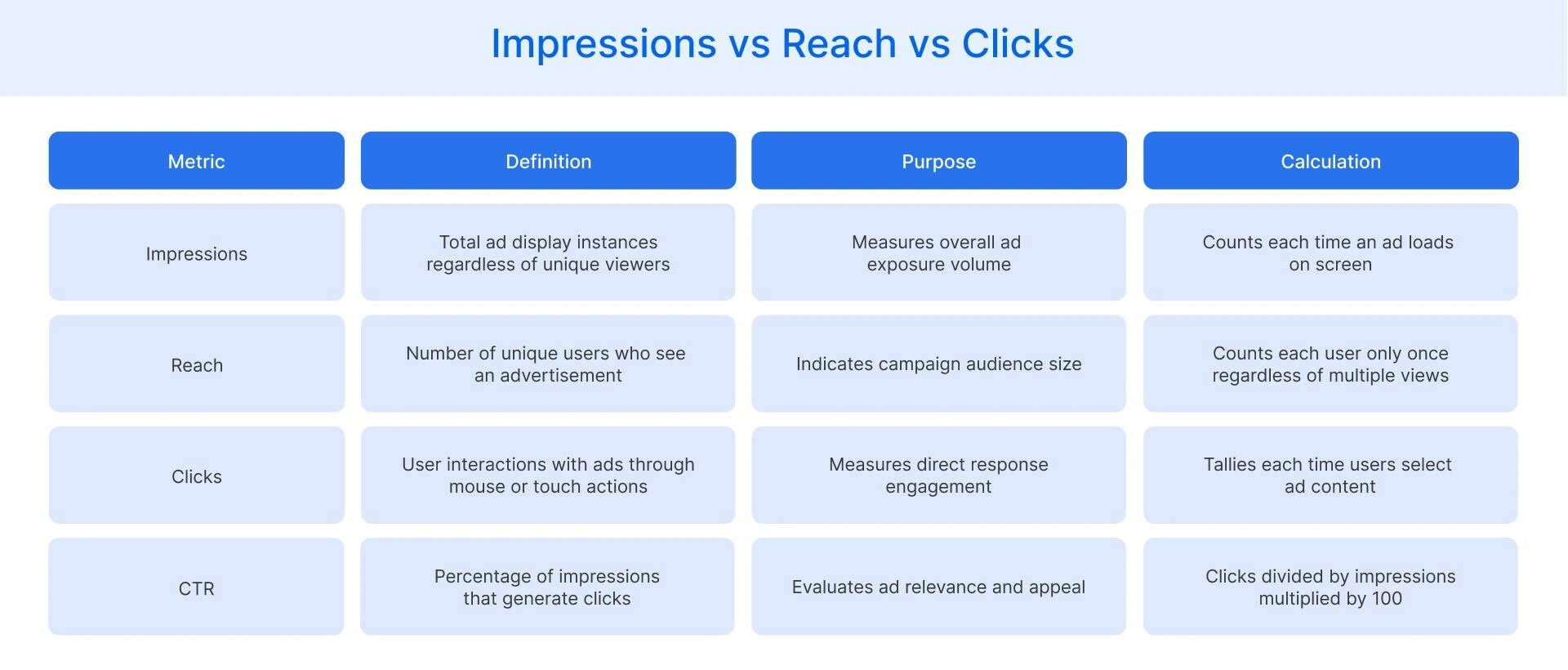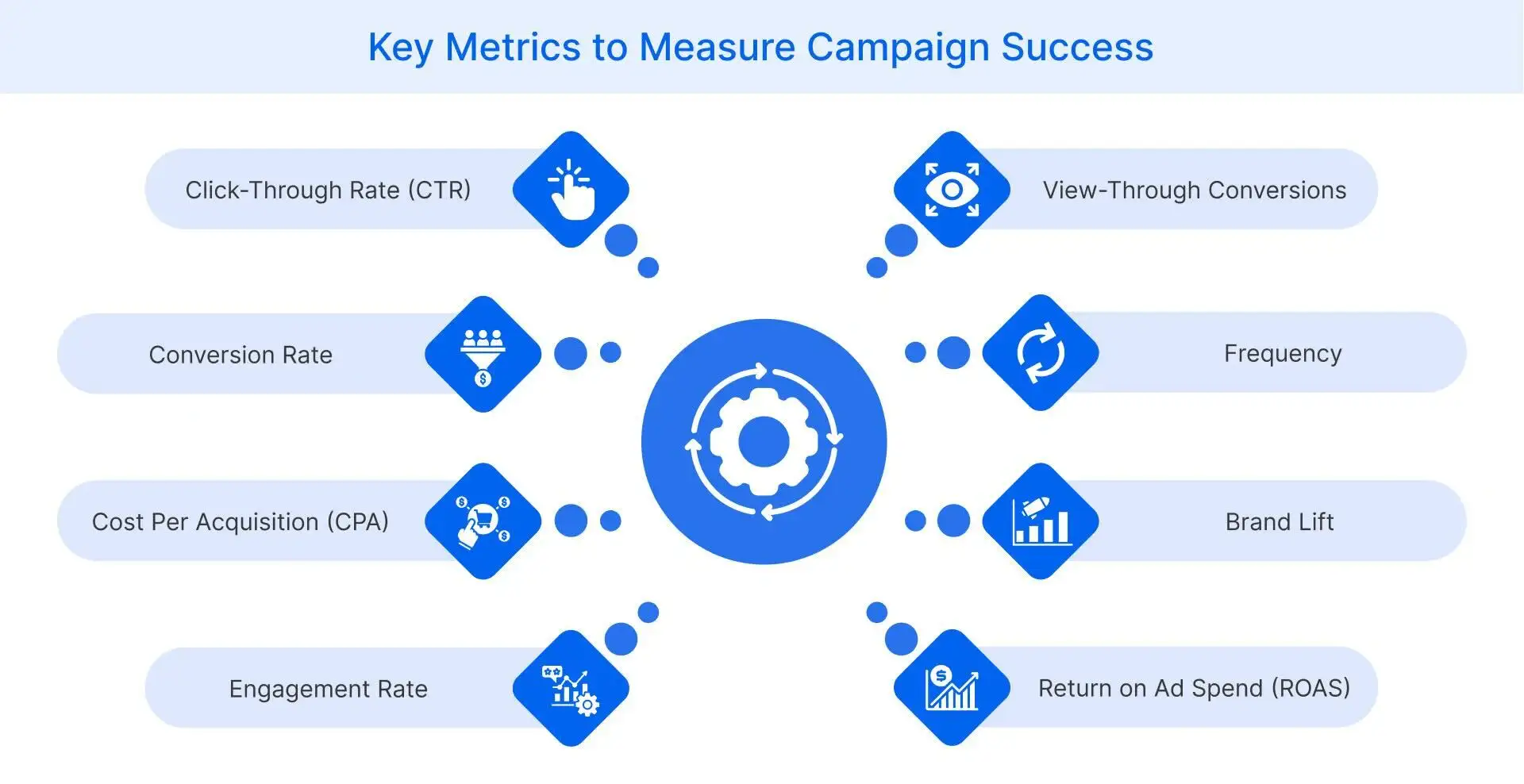Table of Contents
- What is Impression in Advertising?
- Why are Ad Impressions Important?
- How Do Impressions Work in Digital Advertising?
- How are Ad Impressions Measured?
- What is the Difference Between Impressions, Reach, and Clicks?
- How Do Impressions Affect Advertising Costs?
- What are Viewable Impressions?
- How Can Retailers Optimize for Quality Impressions?
- What Metrics Work with Impressions to Measure Campaign Success?
- What are the Limitations of Impression Advertising?
What is Impression in Advertising?
An impression in advertising represents each individual instance when an advertisement appears on a user's screen through a website, social media platform, or search engine results page. Unlike clicks or conversions, impressions simply count exposures regardless of user interaction, making them a fundamental baseline metric in digital marketing impression campaigns.
- Impressions measure potential ad visibility rather than guaranteed viewership, as users may scroll past without noticing, similar to billboards on the side of the road in the tangible world.
- Different advertising platforms calculate impressions using varied methodologies, affecting cross-platform campaign analysis and ad performance.
- Single users may generate multiple impressions by seeing the same advertisement repeatedly across different sessions.
- Viewable impressions specifically count only ads that meet industry-standard visibility thresholds for meaningful exposure.
- Impressions form the foundation for calculating other important metrics like click-through rates and cost-per-thousand impressions (CPM), providing a better understanding of ad effectiveness.
Why are Ad Impressions Important?
Impressions provide marketers with essential visibility data that helps evaluate campaign reach before user engagement occurs, forming a baseline metric for the success of an impressions marketing campaign.
- Impression metrics establish baseline awareness measurements, allowing retailers to quantify how many potential customers encountered their brand messaging.
- High impression volumes create repeated exposure opportunities, contributing to improved brand recognition and recall among target audiences.
- Impression data helps identify pattern trends across different channels, enabling more effective media budget allocation decisions.
- When combined with engagement metrics, impressions create valuable conversion ratios that reveal campaign efficiency and audience responsiveness.
- Impression analysis allows marketers to test creative variations with controlled experiments before scaling to larger audience segments.
How Do Impressions Work in Digital Advertising?
Delivery of a digital marketing impression relies on complex technological infrastructure that connects advertisers with available ad spaces across the internet in milliseconds, providing the opportunity for an advertisement to be seen.
Impression delivery in digital advertising relies on complex technological infrastructure that connects advertisers with available ad spaces across the internet in milliseconds.
- Ad servers receive requests when users load webpages, matching available inventory with advertisers' targeting parameters.
- Programmatic advertising platforms use real-time bidding to determine which impressions are purchased and displayed to specific users.
- Social media platforms generate impressions by inserting promotional content into users' feeds based on demographic and behavioral data.
- Search engines display sponsored results alongside organic listings, creating impressions when queries match advertisers' keyword selections.
- Ad networks aggregate impression opportunities across multiple websites, allowing advertisers to reach audiences across diverse digital properties simultaneously.
How are Ad Impressions Measured?
Measuring impressions in advertising involves diverse methodologies and technologies to ensure accurate counts across platforms. The current standard, like viewability guidelines established by the Association of National Advertisers and the American Association of Advertising Agencies, distinguishes between ads merely served and those genuinely seen. This provides a clearer picture of actual audience exposure.
- Server-Side Tracking: Ad servers log every instance an ad unit loads on a user’s device. This initial count is fundamental to every digital marketing impression.
- Client-Side Tracking: Tracking pixels or JavaScript tags embedded in the ad code send data back when an ad loads. This method often verifies server counts.
- Viewability Standards: Industry bodies like the IAB establish rules for what constitutes a "viewable" impression. This typically means a certain percentage of the ad must be on screen for a minimum duration.
- Served vs. Viewable Impressions: A served impression counts every time an ad is delivered, while a viewable impression ensures the ad was actually visible to the user, enhancing data quality and providing a better understanding of true exposure.
- Platform-Specific Metrics: Each advertising platform (e.g., Google Ads, Meta Ads) employs its own internal mechanisms and definitions for measuring impressions, often with its own viewability filters.
What is the Difference Between Impressions, Reach, and Clicks?
Impressions, reach, and clicks represent distinct dimensions of advertising performance that work together to provide a comprehensive view of campaign effectiveness. Impressions count total ad views, reach measures audience size, while clicks track direct engagement actions that indicate deeper interest.

How Do Impressions Affect Advertising Costs?
Impression in advertising directly influences pricing models, particularly in formats where advertisers pay for exposure. Understanding this relationship is vital for managing your advertising budget effectively and optimizing campaign efficiency.
- CPM (Cost Per Mille/Thousand): This widely used model charges advertisers for every thousand ad impressions. It is a common pricing structure for display and video ads, where broad exposure is the primary goal.
- Impression-Based vs. Performance-Based: Unlike models such as CPC (Cost Per Click) or CPA (Cost Per Acquisition), impression-based pricing focuses on visibility rather than direct user action. You pay for the opportunity to be seen.
- Budget Allocation: Your total ad spend can be directly linked to the number of impressions you aim to achieve. Higher impression targets typically translate to higher costs.
- Frequency Capping: Advertisers often implement frequency caps to limit the number of times a single user sees an ad, which can help control impression costs and prevent ad fatigue.
- Campaign Goals: For brand awareness campaigns, maximizing impression in advertising is often a key objective, making CPM a suitable and cost-effective pricing model.
What are Viewable Impressions?
The concept of viewable impressions refines the traditional understanding of impression in advertising, ensuring that an ad was not just served but actually had the opportunity to be seen by a user. This distinction addresses the challenge of ads loading outside a user's visible screen area.
Industry standards, such as those set by the Interactive Advertising Bureau (IAB), define viewability. For display ads, the IAB typically requires at least 50% of the ad's pixels to be in view for at least one continuous second. For video ads, the standard is usually 50% of pixels in view for at least two continuous seconds.
This distinction between served impressions and viewable impressions is crucial for advertisers. It provides a more accurate measure of actual ad exposure, allowing for better evaluation of campaign effectiveness and ensuring that advertising spend is directed towards ads with a higher probability of being seen. Focusing on viewable impression in advertising optimizes budget allocation..
How Can Retailers Optimize for Quality Impressions?
Strategic impression optimization enables retailers to maximize advertising impact by ensuring ads reach receptive audiences in appropriate contexts.
- Target high-intent audience segments based on recent browsing behavior rather than broad demographic characteristics alone.
- Prioritize premium placement positions where users naturally focus attention, such as above-the-fold locations or content-integrated areas.
- Implement frequency capping to prevent impression wastage and audience fatigue from excessive ad repetition.
- Design visually distinctive creative elements that capture attention quickly within crowded digital environments.
- Schedule impression delivery during peak shopping periods when user engagement and conversion probability increase substantially.
What Metrics Work with Impressions to Measure Campaign Success?
Impression data becomes significantly more valuable when analyzed alongside complementary metrics that reveal how audiences respond after ad exposure.
- Click-Through Rate (CTR): Calculates the percentage of impressions that generate direct user interaction.
- Conversion Rate: Measures the proportion of impressions ultimately leading to desired business actions.
- Cost Per Acquisition (CPA): Determines the impression expense required to generate each customer conversion.
- Engagement Rate: Tracks how users interact with a piece of content beyond simple clicks.
- View-Through Conversions: Attributes conversions to impression exposure even without direct ad clicks.
- Frequency: Calculates the average number of impressions delivered to individual users.
- Brand Lift: Quantifies changes in awareness, perception, or recall resulting from impression campaigns.
- Return on Ad Spend (ROAS): Compares revenue generated against total impression-based advertising investment.

What are the Limitations of Impression Advertising?
While impressions provide essential visibility metrics, they present several inherent challenges that marketers must address to evaluate advertising performance accurately.
- Bot Traffic: Artificial impression generation from non-human sources artificially inflates campaign numbers without delivering actual consumer exposure.
- Viewability Issues: Many served impressions remain unseen when positioned outside viewable screen areas or scrolled past too quickly.
- Attribution Complexity: Impressions often influence purchase decisions without receiving proper credit in multi-touch conversion paths.
- Context Blindness: Raw impression counts fail to distinguish between premium and low-quality placement environments affecting brand perception.
- Correlation Limitations: High impression volumes don't necessarily translate to proportional increases in business outcomes or revenue generation.
Conclusion
Impression in advertising is a foundational metric within the digital marketing ecosystem, signifying an ad's basic visibility. While crucial for measuring exposure and brand awareness, it functions best when analyzed alongside other performance indicators.
Retailers can leverage impression data for strategic business growth by understanding its role, optimizing for quality, and recognizing its limitations. This holistic approach ensures more effective advertising investments and informed decision-making.
FAQ
Impression fraud and invalid traffic artificially inflate impression counts, wasting ad spend. These deceptive practices can skew campaign performance data, leading to misinformed optimization decisions. They diminish the overall effectiveness and trustworthiness of impression in advertising metrics.
Impression in advertising plays a role in attribution modeling by representing initial exposure points. While impressions alone don't signify conversion, they contribute to understanding the customer journey. Multi-touch attribution models often consider impression data as part of the overall path to conversion.
Ad blockers prevent advertisements from loading, directly reducing measured impression in advertising counts. This means that users employing ad blockers will not generate impressions, leading to an underestimation of potential reach. Advertisers must consider this impact when analyzing campaign data.
No, not all impressions are considered viewable. A served impression simply means the ad loaded, while a viewable impression adheres to industry standards, ensuring the ad was actually visible on screen for a specified duration. This distinction is crucial for accurate measurement of impression in advertising.

